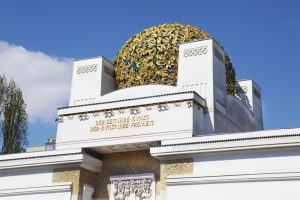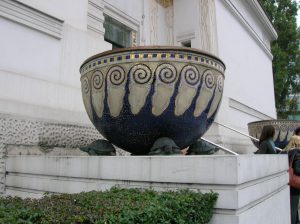The Secession House in Vienna
By Tracy A. Burns
Secession style
Perhaps Vienna’s Secession House is the ultimate symbol for the Secession style – also called Art Nouveau. Established in 1897 by a group of artists guided by Austrian symbolist painter Gustav Klimt, the Secession organization devoted itself to Modernism. Yet there is no singular distinctive style that defines this movement. The artists rebelled against the conservative Vienna Künstlerhaus that focused on Historicism. The Secession members wanted to create works that were not influenced by history, a genre not connected with academics. Architects of this style tended to design buildings boasting geometric shapes. Also, they incorporated decorative elements stemming from nature, such as leaves, animals, or grapevine shoots. Three-dimensional snake and salamander forms also adorned structures.
The exterior of the building
 This pavilion-like example of Art Nouveau architecture opened in 1898, hosting the Second Exhibition of Secession, which triggered harsh criticism. Crowned with a gilded dome and conceived as an “art temple,” the Secession House boasts a façade decorated with the words, “To the age its art. To art its freedom.” The entrance is decorated with gilded friezes of foliage. Three female busts representing painting, sculpture, and architecture make appearances, too. Inside, there are temporary exhibitions.
This pavilion-like example of Art Nouveau architecture opened in 1898, hosting the Second Exhibition of Secession, which triggered harsh criticism. Crowned with a gilded dome and conceived as an “art temple,” the Secession House boasts a façade decorated with the words, “To the age its art. To art its freedom.” The entrance is decorated with gilded friezes of foliage. Three female busts representing painting, sculpture, and architecture make appearances, too. Inside, there are temporary exhibitions.
Klimt’s Beethoven Frieze
But the highlight is Klimt’s Beethoven Frieze, created for the 14th exhibition of the Association of Visual Artists – Vienna Secession in 1902 and considered one of the premiere examples of Viennese Secession. During that exhibition 21 Secession artists flaunted their works, paying tribute to composer Ludwig van Beethoven, who lived and worked in Vienna until his death on March 26, 1827. The showing centered on Max Klinger’s colored, three-dimensional sculpture of Beethoven. The Beethoven Frieze occupied the first space viewed at the 1902 exposition.
Its theme and inspiration
Inspired by Richard Wagner’s interpretation of Beethoven’s Ninth Symphony, the frieze recounts humankind’s quest for happiness. Significantly, the Ninth Symphony was Beethoven’s last, and it is unique because it demands soloists and a mixed choir.
The first wall and the golden knight
The first wall of the frieze is divided into the sections “Floating Genii,” “Suffering Humanity” and “Knight in Shining Armor.” The reoccurring genii guides the spectator into the tale depicted by a naked woman standing and a naked couple kneeling as they plead to a knight in glittering, golden armor for assistance. Thus, suffering and humanity make allegorical appearances. The allegorical figures of Ambition and Compassion play roles, too, as they accompany the dashing knight on his quest.
The second wall and the shaggy monster
The next wall is narrower than the others. It is divided into the sections “Hostile Forces,” “Gorgons” and “Typhoeus,” a shaggy, blue-winged giant with a body reminiscent of a snake. His pearl-like eyes capture the viewer’s full attention. Take a look at the snakes slivering through the hair of the three Gorgons, who are the giant’s daughters. Above the Gorgons, female heads standing for Sickness, Madness, and Death make unsettling appearances. To the right of Typhoeus are the embodiments of Lasciviousness, Wantonness, and Intemperance. Do not overlook the emaciated, grieving female figure pictured so poignantly, emotionally torn apart by sorrow. Humankind’s hope to conquer these evil forces is illustrated by the head of a genie at the top right of the narrow wall.
The third wall and the lady with the lyre
The third wall is more positive and enlightening, divided into “Poetry,” “The Arts” and “Choir of Angels.” Here the viewers see that happiness has been attained via poetry, portrayed by a female figure playing the lyre. A part of the wall is conspicuously empty: During the 1902 exposition visitors could view Klinger’s Beethoven from this area.
The joyous finale
The final scene is triumphant. Female figures delve into the world of art. A couple of kisses in front of the “Choir of Angels.” (Remember that the Ninth Symphony is noted for its choir section.) This tableau symbolizes art for Klimt, echoing the final chorus of Beethoven’s last symphony that took its inspiration from Friedrich von Schiller’s poem “Ode to Joy,” which celebrates the phrase, “This kiss to the whole world.” Notably, the movement, along with Schiller’s poem, was adopted by the European Union as its hymn in 1985. Klimt certainly is no stranger to creating kissing scenes as perhaps his most famous work is entitled, “The Kiss,” exhibited at Vienna’s Belvedere Palace. Klimt focused on female figures and eroticism throughout his career. Many see the fears and sorrows of World War I prophetically portrayed in Klimt’s creations.
From 1903 to 1986: The frieze’s history
 The Beethoven Frieze made another appearance at the Klimt Retrospective in 1903. In 1915 it was placed in a private collection. In 1938 the Nazis confiscated the painting, which remained in Austria. In 1973 the masterpiece of Art Nouveau was bought by the Austrian state. It then underwent a 10-year restoration period. The Secession House became its home in 1986.
The Beethoven Frieze made another appearance at the Klimt Retrospective in 1903. In 1915 it was placed in a private collection. In 1938 the Nazis confiscated the painting, which remained in Austria. In 1973 the masterpiece of Art Nouveau was bought by the Austrian state. It then underwent a 10-year restoration period. The Secession House became its home in 1986.


